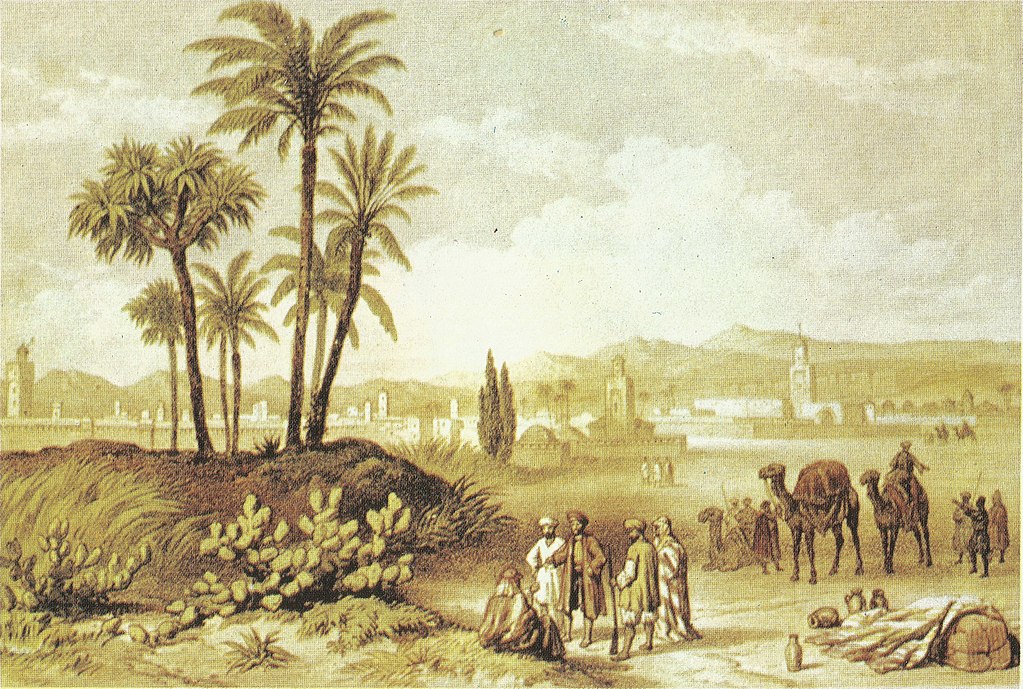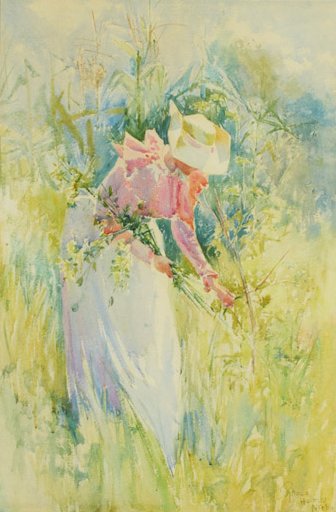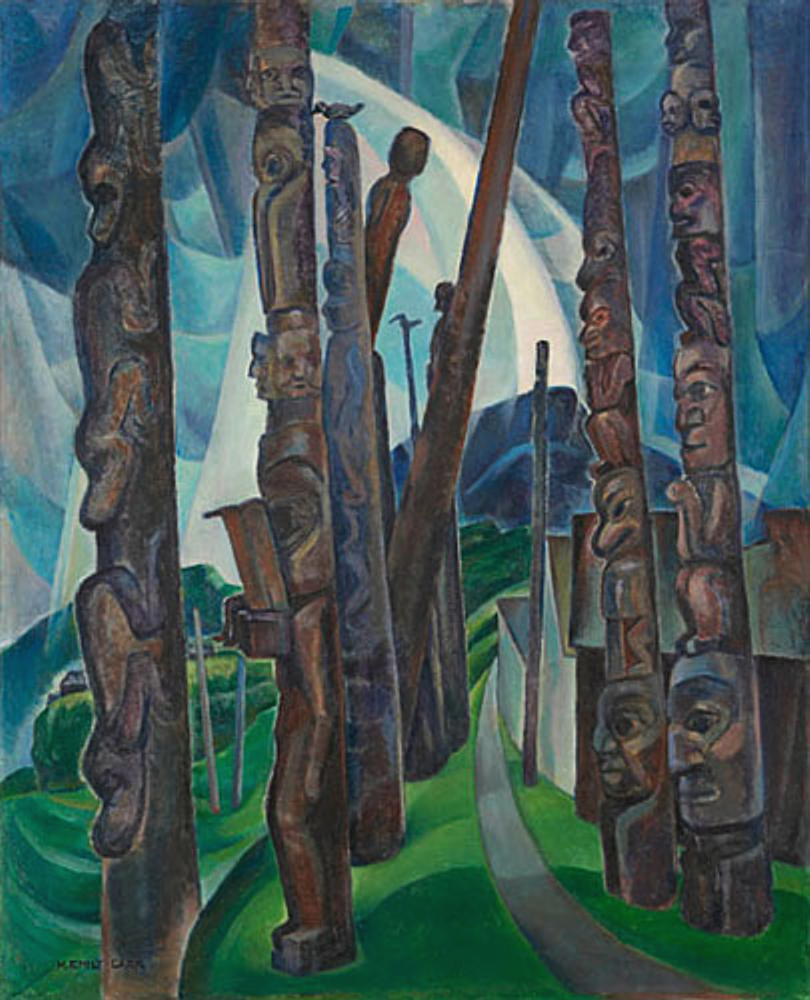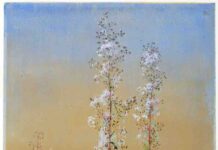ELIZABETH MURRAY (British, 1815 – 1882)

British artist Elizabeth Murray learned watercolor painting from her father, Thomas Heaphy, who was also a watercolorist. The two traveled together and Murray spent extensive time in Rome, Morroco, and the Canary Islands. Over the course of 10 years, she painted the landscape as well as portraits from her travels, too. Her works are known for her color choices which use brown, violet, blue, black, red, and gold as well as olive and tan colors to give them a warm-toned appearance.
One of the most prominent British watercolor painters, Elizabeth Murray spent ten years living in the Canary Islands, so naturally many of her works are inspired by its landscapes and people, but also those of Morocco and Andalusia. Learning the craft from her father Thomas Heaphy, she developed a recognizable style and used the “traditional English method” – she superimposed fine layers of elaborately mixed colors to create an effect of color and depth. Elizabeth Murray is also the founder of The Society of Female Artists in London.
Rhoda Holmes Nicholls (British-American, 1854–1930)

Rhoda Holmes Nicholls was an English-American watercolor and oil painter, born in Coventry, England. She studied art in England and Italy, and her work was viewed and praised at the time by the queens of both countries. A body of work was created in South Africa by Nicholls of Port Elizabeth area’s scenery, wildlife and architecture. She lived there on her brothers’ 25,000-acre ostrich farm for one year.
Her watercolor paintings and illustrations were published in journals, and her oil paintings won awards in the United States and Europe. Nicholls was a successful artist, writer and art instructor. She was actively involved in many art organizations as a member and leader.
Nicholls invented tools and techniques for watercolor paintings, was an innovator in the use of color in her painting of shadows, and was considered “one of the foremost painters of Venetian subjects” in the United States.

Her paintings were shown at the MacDowell Club, which was established by women to exhibit and promote their works. She was a member of the Woman’s Art Club of New York. Nicholls was made vice-president of the New York Water Color Club and belonged to the American Society of Miniature Painters and the American Water Color Society. Nicholls served as co-editor of Palette and Bench.
Nicholls taught art from her 7th Avenue studio in New York, at the Art Students League of New York, William Merritt Chase’s Shinnecock School of Art on Long Island, and in towns in the eastern United States.
MARION K. WACHTEL (American, 1870-1954)

Marion Kavanagh (born Kavanaugh) Wachtel was born on June 10, 1870, in Milwaukee, Wisconsin. Her parents were James Thomas Kavanaugh and Jane Johnston Kavanaugh. She was raised in a home that encouraged artistic pursuits, as her mother and her great grandfather, who had been a member of the Royal Academy in London, were artists.
She studied at the Art Institute of Chicago and in New York with William Merritt Chase (1849-1916). For several years, she taught at the Art Institute and in the Chicago public schools. By the time she returned to Milwaukee, she had established a reputation for child portraits and figure studies.
In 1903, she won a commission from the Santa Fe Railroad to paint murals in their San Francisco ticket office. With the benefit of a pass from Santa Fe, she set off to California sketching at every opportunity along the path of the railroad.
Also in 1903, Marion visited the Cooper Ranch in Santa Barbara, and stayed as a guest for a few months. The Cooper Ranch was owned by Ellwood Cooper (1829-1918), a brilliant agriculturist and horticulturist who published several treatises on California produce. On his ranch, Cooper grew olives, grapes, English walnuts, European almonds, oranges, lemons and Japanese persimmons. He was the first farmer in the United States to produce and market olive oil.
Soon after her stay in Santa Barbara, Marion travelled to San Francisco. In October, 1903, she showed several of her watercolors at the home of Mrs. Oscar K. Cushing. The show consisted of landscapes painted in and around Santa Barbara and the Cooper Ranch, as well as a series of small portraits, all in watercolor. The display was reviewed in the San Francisco Chronicle of Monday, October 19, 1903. In all, the show was well received, and the writer stated that “She handles watercolors in a free, fearless way, more like a man than a woman.”
Once in San Francisco, she familiarized herself with the city by visiting art studios and galleries. It has been often stated that Marion met and took classes with William Keith (1838-1911), and that Keith introduced her to his friend Elmer Wachtel (1864-1929), who lived in Los Angeles. Unfortunately, there are no extant sources to verify these two events. By contrast, there is no doubt that Keith and Elmer Wachtel were indeed friends, as Elmer had studied with Keith in San Francisco between 1892 and 1894.
Whatever it was that brought Marion Kavanaugh and Elmer Wachtel together, the two artists fell in love and were married in Chicago in 1904. Thereafter she signed her name “Marion Kavanagh Wachtel.”
Returning to Los Angeles, the couple built a studio-home in the Mt. Washington area. They remained there until 1921 when they moved to the Arroyo Seco area of Pasadena. As inseparable painting companions, they traveled throughout Southern California and the Southwest. Originally trained as a portrait artist, Wachtel painted portraits of the Hopi on a trip to Northern Arizona and New Mexico in 1908.
Marion worked primarily in watercolor throughout their marriage. She earned a reputation as one of the very best watercolorists in California. Her paintings display remarkable dexterity in the handling of the medium, which could be quite unforgiving even to the most skilled. She received high praise for her works, as delicate, lyrical interpretations of the landscape, in a manner that showed her masterful control of tone and color.
At all times, Marion was a great artist, showing a studied approach to the sensitive character of natural light and a love for elegant forms. She was popular on both coasts and exhibited in New York as well as California. She was elected to the New York Water Color Club in 1911, was elected an associate of the American Water Color Society in 1912, and was a founding member of the California Water Color Society in 1921.She also held memberships in the Pasadena Society of Artists and the Academy of Western Painters. Her works were exhibited jointly with her husband’s as well as in solo exhibitions in Los Angeles. One-person exhibitions of her paintings were held at the Los Angeles Museum of History, Science, and Art in 1915 and 1917.
After her husband’s death in 1929, Marion Wachtel temporarily lost interest in painting. She resumed working around 1931, painting landscapes around her home on the Arroyo Seco, the foothills of the San Gabriel Mountains, and several views of the Sierra Nevada Mountains, many of which are done in oil paint. Marion Wachtel died at home in Pasadena on May 22, 1954.
Written by (Mr.) Jean Stern
Retired Executive Director of California Impressionism
The Institute and Museum for California Art
University of California, Irvine
MARY ROBINSON BLAIR (American, 1911 – 1978)

Mary Blair was an American artist, animator, and designer. She began her lifelong multifaceted art career in the 1930’s as a member of the prestigious California Watercolor Society. She was prominent in producing art and animation for The Walt Disney Company, drawing concept art for such films as Alice in Wonderland, Peter Pan, Song of the South and Cinderella. Blair also created character designs for enduring attractions such as Disneyland’s It’s a Small World, the fiesta scene in El Rio del Tiempo in the Mexico pavilion in Epcot’s World Showcase, and an enormous mosaic inside Disney’s Contemporary Resort. Several of her illustrated children’s books from the 1950s remain in print, such as I Can Fly by Ruth Krauss. Blair was inducted into the group of Disney Legends in 1991.
Emily Carr (Canadian, 1871-1945)

Emily Carr was a Canadian artist and writer who was inspired by the Indigenous peoples of the Pacific Northwest Coast. One of the first painters in Canada to adopt a Modernist and Post-Impressionist style, Carr did not receive widespread recognition for her work until she changed subject matter from Aboriginal themes to landscapes—forest scenes in particular. As a writer Carr was one of the earliest chroniclers of life in British Columbia. The Canadian Encyclopedia describes her as a “Canadian icon”.
members of the Group of Seven, at that time Canada’s most recognized modern painters.Lawren Harris of the Group became a particularly important support: “You are one of us,” he told Carr, welcoming her into the ranks of Canada’s leading modernists. The encounter ended the artistic isolation of Carr’s previous 15 years, leading to one of her most prolific periods, and the creation of many of her most notable works. Through her extensive correspondence with Harris, Carr also became aware of and studied Northern European symbolism.
Carr’s artistic direction was influenced by the Group, and by Lawren Harris in particular, not only by his work, but also by his belief in Theosophy. Carr struggled to reconcile this with her own conception of God. Carr’s “distrust for institutional religion” pervades much of her art. She became influenced by Theosophic thought, like many artists of the time, and began to form a new vision of God as nature. She led a spiritual way of life, rejecting the Church and the religious institution. She painted raw landscapes found in the Canadian wilderness, mystically animated by a greater spirit.








Thank you for featuring women who painted in watercolors. I enjoyed reading about some history of the medium.
Reading about the women artists was an eye opener for me. To know that they became historical figures in watercolor painting for their masterful skill, subject, and style. Thank you.
Thank you for shining the light on female artists! I really enjoyed the article. I will forward it to my Studio 10 ladies.
I throughly enjoyed your writing of the artist. You have inspired me to get out my watercolors and continue developing my skills, thank you!
I enjoyed this, but wish you would do a follow-up featuring more contemporary (i.e., living and working) women watercolorists! There are many worthy of this attention…
Emily Carr is very well known and loved in Canada. Her work is on display at the National Gallery in Ottawa , the Art Gallery of Ontario in Toronto, the Vancouver Art Galley and her home in Victoria B.C. is open to the public. Hopefully the American public will come to enjoy her work as much as her fellow Canadians!
I love Emily Carr’s work; I have her book and a couple of years ago there was an exhibition in London- Wonderful